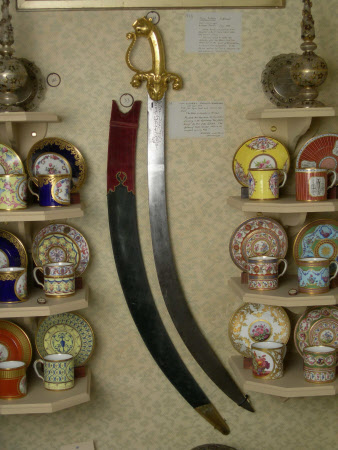Scabbard
Category
Arms and armour
Date
1782 - 1799
Materials
Leather, velvet and silver gilt
Measurements
835 mm (L)
Place of origin
Mysuru (Mysore)
Order this imageCollection
Powis Castle and Garden, Powys
NT 1180589.2
Summary
Leather scabbard, made between 1782 and 1799, in Mysuru (formerly known as Mysore), India. Covered in green and red velvet with silver gilt locket. The scabbard shape and style are common to Indian scabbards over a long period, see for example NT 1180591.2 and RCIN 11322 at the Royal Collections Trust.
Full description
This scabbard is paired with sword NT 1180589. Both are associated with Tipu Sultan (1750-99), the ruler of Mysuru (formerly known as Mysore). Tipu Sultan succeeded his father as ruler of the South Indian state of Mysuru in 1782, where he built a sophisticated court around his palace at Srirangapatna (formerly known as Seringapatam). Tipu was a powerful ruler whose reign was characterised by military conflict and reform. During his 17-year reign, Tipu introduced direct revenue collection, changes to land ownership, investment in agriculture and industrialisation, and social reforms. He also supported the establishment of factories and trading companies beyond Mysuru and the immigration of skilled foreign workers in order to develop local capability to produce modern firearms [Satyanarayana, p. 2245-7]. Research Note on Provenance Tipu Sultan spent much of his reign engaged in the defence of Mysuru against encroachment by the British East India Company. In 1798, a renewed British campaign provoked the Fourth Anglo-Mysore War. On 4th May 1799, during the Siege of Srirangapatna, Tipu was killed. In the immediate aftermath, the British army looted the town. According to Colonel Arthur Wellesley, later the Duke of Wellington, ‘Scarcely a house in the town was left unplundered, and I understand that in camp jewels of the greatest value, bars of gold etc etc have been offered for sale in the bazaars of the army by our soldiers, sepoys and followers. I came in to take command of the army on the morning of the 5th and with the greatest exertion, by hanging, flogging etc etc in the course of that day I restored order…’ [Dalrymple, p. 351]. The resumption of control by the higher ranks of the army enabled the work of the prize committee to begin. Prize committees were responsible for ‘collecting, inventorying and disposing of booty seized from the enemy and for … seeking to establish combatants’ entitlement to prize' [Finn, p.17]. They were intended to prevent the kind of undisciplined plunder which Wellesley reported in the aftermath of Tipu’s defeat at Srirangapatna. More than 1,000 commissioned officers took their allotted share in the captured property, which they kept, exchanged or sold to others. High value, or high-profile items, were excluded from the prize committee’s remit, and given to senior civil and military personnel, as well as the British royal family. Not all articles were genuine: tenuous or spurious attributions to Tipu Sultan have been identified in objects which were brought to Britain. Recent work on a sword at the Wallace Collection [OA1402] has shown that an inscription on the blade suggesting personal ownership by Tipu was added after his death in 1799. It is unclear who removed this scabbard and its associated sword from Srirangapatna, but it most likely occurred after the British army sacked the city. They may have been given to Edward Clive (1754-1839), then Governor of Madras (1798-1803), by Lieutenant Colonel James Brunton, Military Auditor General in Madras. In a letter dated 10th September 1803, Brunton described a 'Sword which was the property of the late Sultan of Mysore procured for me at the Sale of his effects by one of the Prize Agents, as it is genuine, and a Curiosity, Your Lordship may be pleased to possess it.' [Archer et al., p. 47]
Provenance
Accepted by HM Treasury on 21st March, 1963 in lieu of tax and conveyed to National Trust ownership on 29th November 1963.
References
2019 Dalrymple: W Dalrymple, The Anarchy: The Relentless Rise of the East India Company, Bloomsbury 2019 2018 Finn: Margot Finn, ‘Material Turns in British History I: Loot’, Transactions of the Royal Historical Society, Vol. 28, December 2018 2004 Satyanarayana: A Satyanarayana ‘Review: The Mysore Sultans. State and Diplomacy under Tipu Sultan: Documents and Essays by Irfan Habib’ Economic and Political Weekly 39 24 (2004) 1995 Brittlebank: K Brittlebank, ‘Sakti and Barakat: The Power of Tipu’s Tiger. An Examination of the Tiger Emblem of Tipu Sultan of Mysore’, Modern Asian Studies 29 2 (1995) Archer, Rowell and Skelton 1987 Mildred Archer, Christopher Rowell, and Robert Skelton, Treasures from India: The Clive Collection at Powis Castle, London, 1987
